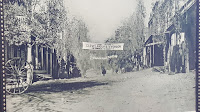Angels Camp and the California Goldrush
Snoqualmie Falls in a time of COVID-19
Okay, for those of you unfamiliar with the Pacific
Northwest, Snoqualmie Falls is a 268-foot waterfall on the Snoqualmie River,
between the cities of Fall River and Snoqualmie, Washington. Perhaps it is
easier to visualize if I just tell you that from downtown Seattle, get on eastbound Interstate 90 and drive for about fifty minutes and you will run right
into it. There is free parking, a gift shop, a nice lodge, and a 1.4-mile round trip hiking path that runs from the upper viewing area down to a lower viewing
platform. Of course, the real star is the falls themselves. They are beautiful year-round,
but I gather that some dedicated individuals drive up there after a few days of
heavy rain to get a view of the falls on steroids.
The falls have been a spiritual site for Native Americans for thousands of years. The Snoqualmie Tribe, a subgroup of the Coastal Salish people, would gather at the falls each year for trade. (See the official website for a complete history.) Anglo-American settlers moved into the area after the middle of the nineteenth century. Soon after came industrialization. The 1870s brought logging operations. The 1880s brought a town and a railroad. The 1890s brought a hydro-electric powerplant still operating today.
We are still working with COVID-19 restrictions and I was
happy to see that although viewing the falls is an outdoor activity, a vast
majority of people were wearing their masks and doing their best to stay
socially distanced. That social distancing was easily accomplished up top and
on the trail down. But as you get to the bottom, the trail narrows to a
boardwalk that goes past the old 1911 powerplant building and out to a viewing
platform. Unfortunately, when we got down there, it was busy. A crowd that
could stay distanced in the upper viewing area could not on the sidewalk-width
of the boardwalk. Folks were patient and queued up nose-to-back along the
boardwalk waiting for their turn to go out onto the viewing platform. But that’s
not the point.
Everyone was cooperating and waiting their turn. That was great. But there was no guide or park ranger (this is not a state or national park) to keep people distanced. And hardly anyone would have seen this situation as dangerous while we are fighting a pandemic. We decided it was not worth it and left the line after about a minute when we realized that it could very well be a “super spreader.” I am writing that tongue-in-cheek, but it is true. Sheila and I both have had the “Rona” virus as some of my students call it. Trust me. You do not want it. And we didn’t want to get it again.
Enjoy the pictures and videos. Stop by and see Snoqualmie Falls when
you are driving from Spokane to Seattle. It is worth the stop. Look at the Falls
and think of a much longer history that you are seeing. And double-down on those
protocols: mask, wash hands, stay distanced. The only way to get through the
pandemic is with a little dose of discipline and good judgment.
The California State Railroad Museum
Memories from a pre-covid trip...
Last year I was teaching high school in California and we were sent home to conduct “distance learning” on March 13th and my old school is still at home trying to teach and learn via the Internet. That’s getting close to a whole year. Now, this post is not about the merits of distance learning or whether students should be in the classroom during a surge in the pandemic. When I decided to share some pictures of the California State Railroad Museum I was reminded that people in professions other than hospitality and travel are having a hard time during this crisis as well. There are a good number of museum workers at home too.

















